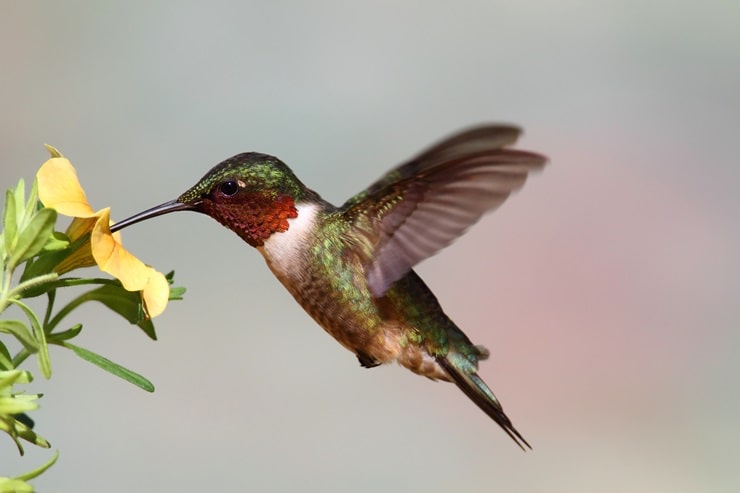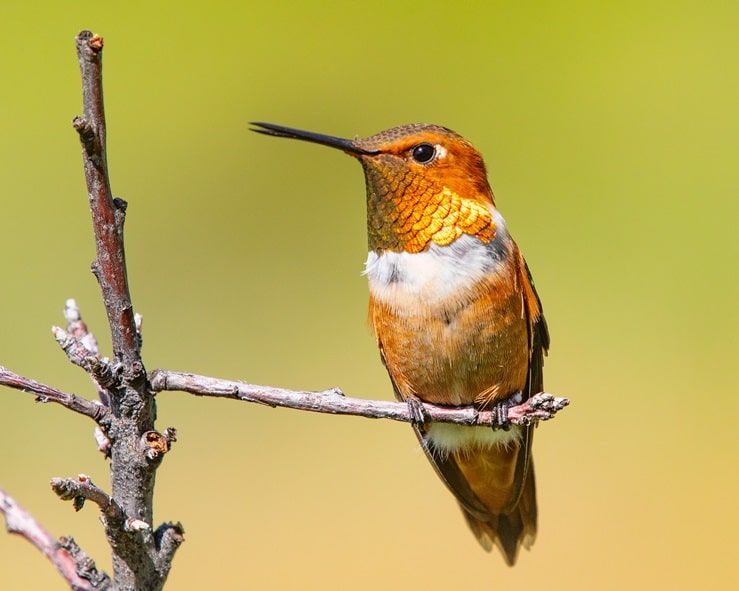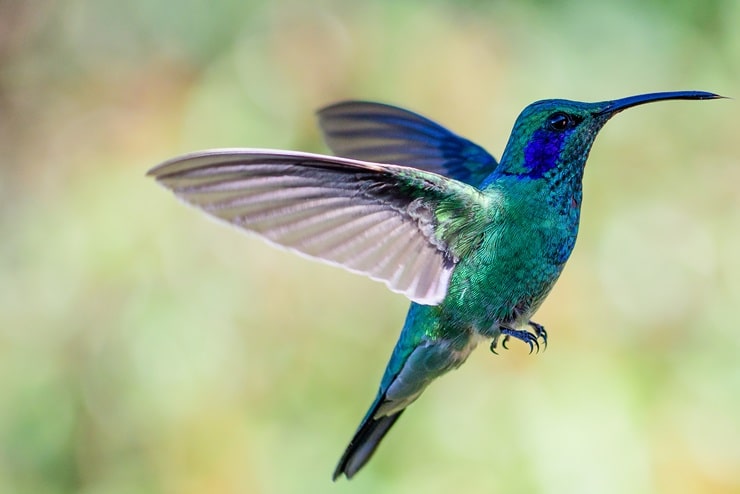It’s always exciting to see a hummingbird. They’re so unique with their incredible colors that shine like jewels. Plus, the way they move, hovering and flitting about, is unlike anything else.
If you live in Vermont and you want a chance to see these birds, hang up a hummingbird feeder or two. Be sure to clean and refill them regularly and you’re sure to see some of these brave little fliers.
Hummingbirds are a New World group of birds, meaning they only live in South, Central, and North America. Within North America, there are 16 native species of hummingbirds and a few visiting species. Of those, just two are common in Vermont, while one other will rarely visit.
Here is the list of species of hummingbirds in Vermont:
- Ruby Throated Hummingbird
- Rufous Hummingbird
- Mexican Violetear
3 Types of Hummingbirds in Vermont
Hummingbirds visit every part of North America, including Vermont.
1. Ruby Throated Hummingbird

- Scientific name: Archilochus colubris
- Size: 2.8-3.5 inches long
- Weight: 0.1-.02 ounces
- Wingspan: 3.1-4.3 inches
Say “hello” to the most common – by far – hummingbird in all of Vermont. In fact, this is the only breeding hummingbird in the eastern part of North America, and the only non-migratory hummingbird in the state.
The male birds are easy to identify by their bright red throats. If you notice a bird that looks somewhat like a ruby-throated, but the throat looks dark red, it’s likely just because the feathers aren’t in good light. Wait until the sunlight hits them, and you’ll see that shining bright throat.
Otherwise, these birds are emerald or golden-green on their backs and grayish-white on the underside. The beaks are black.
These bold birds are frequent visitors to feeders and if you have the chance to watch their antics, take it. They are incredibly agile. They can stop instantly in the air, hover up, down, side-to-side, and backward. Not only do they feed at feeders and in tubular flowers, but they’ll snatch insects out of the air or from webs, as well.
These generalists live in parks, gardens, backyards, meadows, fields, forests, and woodlands.
They fly away in the fall to winter in Central America and they actually fly across the Gulf of Mexico in one single flight without stopping. Very impressive!
When Do They Arrive In and Leave Vermont?
You can see these hummingbirds most often during the summer season throughout Vermont, though they’re usually around from April to October.
2. Rufous Hummingbird

- Scientific name: Selasphorus rufus
- Size: 2.8-3.5 inches long
- Weight: 0.1-.02 ounces
- Wingspan: 4.3 inches
Rufous means “reddish” and that’s what these birds are. When the sunlight hits them, they glow like a lump of burning coal, with a reddish back and a vivid red throat. The females have a little bit of green on their tails and flanks, plus a little spot of orange on their throats.
Even though these birds might just be visiting an area as they migrate, they’re fierce defenders of the area they are in. They will tirelessly chase off any hummingbird that dares come near. They’ll even chase off bigger birds of other species and they’ll dive-bomb humans who come too close to their feeder or nest.
Like ruby-throated hummingbirds, they’re incredibly agile and will feed from feeders and tubular flowers, as well as snatch insects from the air or spider webs. They live in backyards, forests, meadows, and parks.
In the spring, they leave to their breeding grounds on the west coast where they stay from April to July.
When Do They Arrive In and Leave Vermont?
These hummingbirds aren’t common in Vermont, but they aren’t unheard of, either. Watch for them primarily in the summer.
3. Mexican Violetear

- Scientific name: Colibri thalassinus
- Size: 5.25 inches long
- Weight: 0.21 ounces
- Wingspan: 4.25 inches
Formerly known as the green violet-eared hummingbird, these are large for hummingbirds and can be nearly five-and-a-half inches long. Combined with their bright green bodies and violet streaks on the chest and cheeks, it’s easy to spot them as they flit about pine forests and roadsides.
They will visit birdfeeders, but they like to stay hidden as they eat, so if your feeder is out in the open they might not hang out much.
Their populations are concentrated in the southwest US and all of Mexico down through parts of Central America, but these birds are wanderers. You’ll find them as far north as Canada and occasionally across the midwest and Atlantic Coast. They also visit Vermont in extremely rare circumstances.
When Do They Arrive In and Leave Vermont?
Look for these pretty hummingbirds in Vermont during the summer, but be prepared to wait. They’re only spotted once in a blue moon.
How to Attract Hummingbirds
To attract hummingbirds to your yard, pick feeders that have a little perch so you can observe them holding still as well as in flight.
Contrary to common belief, the feeder doesn’t have to be red. These birds don’t care about the color, they just want a nice meal. You can grab a beautiful feeder with perches from Bolite. Don’t die the nectar, either. Clear nectar is totally fine.
You can also use pre-made nectar to attract them. Just be sure to change the nectar frequently and wash the feeder out with hot water and soap. When it’s really hot, you should change your feeder daily. During cooler weather, once a week is fine.
Feeders left uncleaned develop a mold that can kill hummingbirds.
You should also plant stuff like firebush, fuchsia, honeysuckle, trumpet vine, and powder puff trees. Hummingbirds love these.
Other Species of Birds in Vermont:
Woodpeckers in Vermont
Owls in Vermont
